MGT501 Business Environment: BHP Billiton's Strategy & Challenges
VerifiedAdded on 2023/06/15
|13
|2986
|104
Report
AI Summary
This report provides a comprehensive analysis of the external environmental factors affecting BHP Billiton, a multinational corporation in the Anglo-Australian mining, metal, and petroleum industry. It identifies key political, legal, economic, and environmental factors, including the impact of falling demand in China, and proposes solutions based on frameworks like SWOT analysis. The report also examines industry-specific decision-making factors such as diversified revenue streams, centralized marketing activities, and reduction in operational emissions. By leveraging its strengths and opportunities, BHP Billiton can overcome threats and weaknesses, ensuring sustainable growth and maintaining its competitive edge in the global market. The analysis highlights the importance of adapting to changing environmental conditions and proactively managing risks to achieve long-term profitability and success.
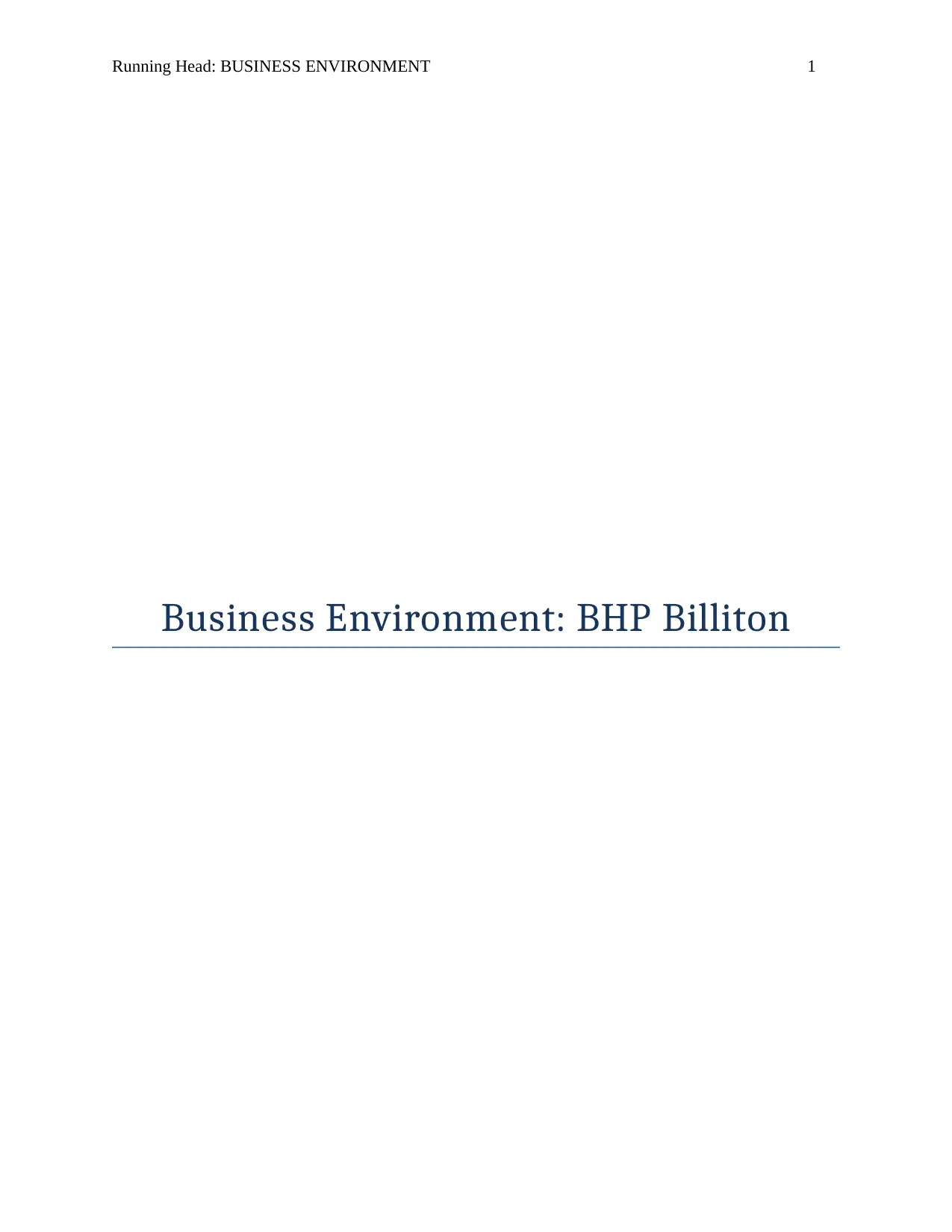
Running Head: BUSINESS ENVIRONMENT 1
Business Environment: BHP Billiton
Business Environment: BHP Billiton
Paraphrase This Document
Need a fresh take? Get an instant paraphrase of this document with our AI Paraphraser
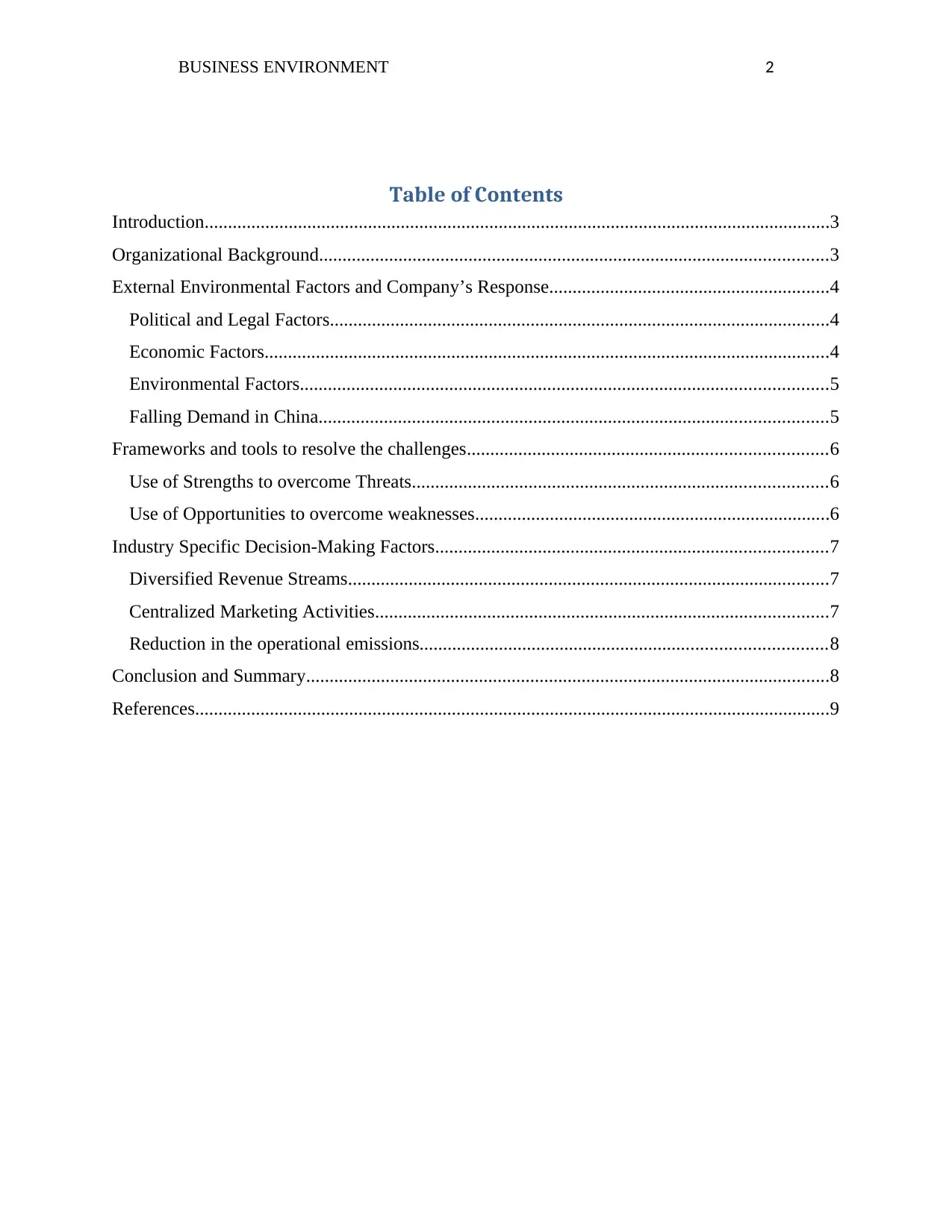
BUSINESS ENVIRONMENT 2
Table of Contents
Introduction......................................................................................................................................3
Organizational Background.............................................................................................................3
External Environmental Factors and Company’s Response............................................................4
Political and Legal Factors...........................................................................................................4
Economic Factors.........................................................................................................................4
Environmental Factors.................................................................................................................5
Falling Demand in China.............................................................................................................5
Frameworks and tools to resolve the challenges.............................................................................6
Use of Strengths to overcome Threats.........................................................................................6
Use of Opportunities to overcome weaknesses............................................................................6
Industry Specific Decision-Making Factors....................................................................................7
Diversified Revenue Streams.......................................................................................................7
Centralized Marketing Activities.................................................................................................7
Reduction in the operational emissions.......................................................................................8
Conclusion and Summary................................................................................................................8
References........................................................................................................................................9
Table of Contents
Introduction......................................................................................................................................3
Organizational Background.............................................................................................................3
External Environmental Factors and Company’s Response............................................................4
Political and Legal Factors...........................................................................................................4
Economic Factors.........................................................................................................................4
Environmental Factors.................................................................................................................5
Falling Demand in China.............................................................................................................5
Frameworks and tools to resolve the challenges.............................................................................6
Use of Strengths to overcome Threats.........................................................................................6
Use of Opportunities to overcome weaknesses............................................................................6
Industry Specific Decision-Making Factors....................................................................................7
Diversified Revenue Streams.......................................................................................................7
Centralized Marketing Activities.................................................................................................7
Reduction in the operational emissions.......................................................................................8
Conclusion and Summary................................................................................................................8
References........................................................................................................................................9
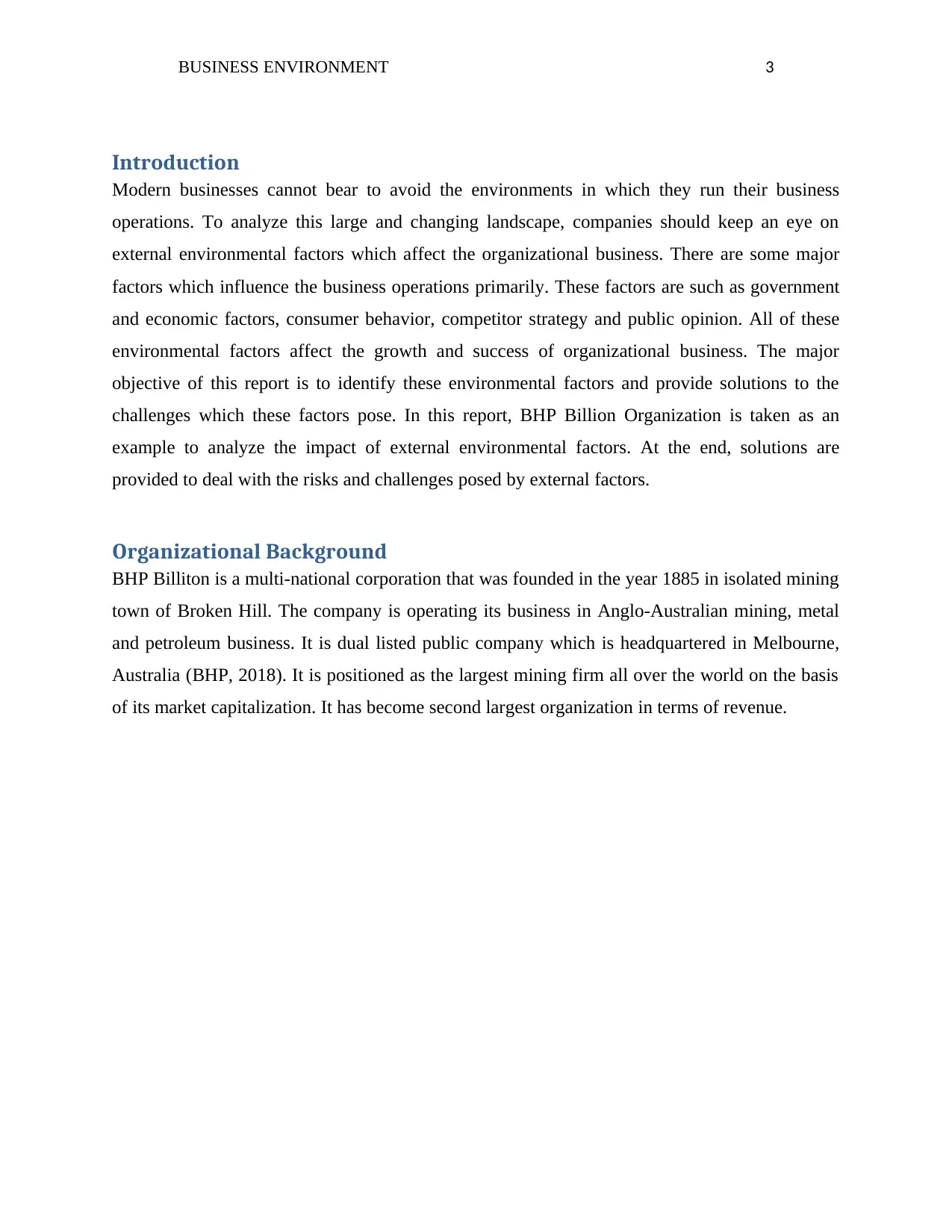
BUSINESS ENVIRONMENT 3
Introduction
Modern businesses cannot bear to avoid the environments in which they run their business
operations. To analyze this large and changing landscape, companies should keep an eye on
external environmental factors which affect the organizational business. There are some major
factors which influence the business operations primarily. These factors are such as government
and economic factors, consumer behavior, competitor strategy and public opinion. All of these
environmental factors affect the growth and success of organizational business. The major
objective of this report is to identify these environmental factors and provide solutions to the
challenges which these factors pose. In this report, BHP Billion Organization is taken as an
example to analyze the impact of external environmental factors. At the end, solutions are
provided to deal with the risks and challenges posed by external factors.
Organizational Background
BHP Billiton is a multi-national corporation that was founded in the year 1885 in isolated mining
town of Broken Hill. The company is operating its business in Anglo-Australian mining, metal
and petroleum business. It is dual listed public company which is headquartered in Melbourne,
Australia (BHP, 2018). It is positioned as the largest mining firm all over the world on the basis
of its market capitalization. It has become second largest organization in terms of revenue.
Introduction
Modern businesses cannot bear to avoid the environments in which they run their business
operations. To analyze this large and changing landscape, companies should keep an eye on
external environmental factors which affect the organizational business. There are some major
factors which influence the business operations primarily. These factors are such as government
and economic factors, consumer behavior, competitor strategy and public opinion. All of these
environmental factors affect the growth and success of organizational business. The major
objective of this report is to identify these environmental factors and provide solutions to the
challenges which these factors pose. In this report, BHP Billion Organization is taken as an
example to analyze the impact of external environmental factors. At the end, solutions are
provided to deal with the risks and challenges posed by external factors.
Organizational Background
BHP Billiton is a multi-national corporation that was founded in the year 1885 in isolated mining
town of Broken Hill. The company is operating its business in Anglo-Australian mining, metal
and petroleum business. It is dual listed public company which is headquartered in Melbourne,
Australia (BHP, 2018). It is positioned as the largest mining firm all over the world on the basis
of its market capitalization. It has become second largest organization in terms of revenue.
⊘ This is a preview!⊘
Do you want full access?
Subscribe today to unlock all pages.

Trusted by 1+ million students worldwide
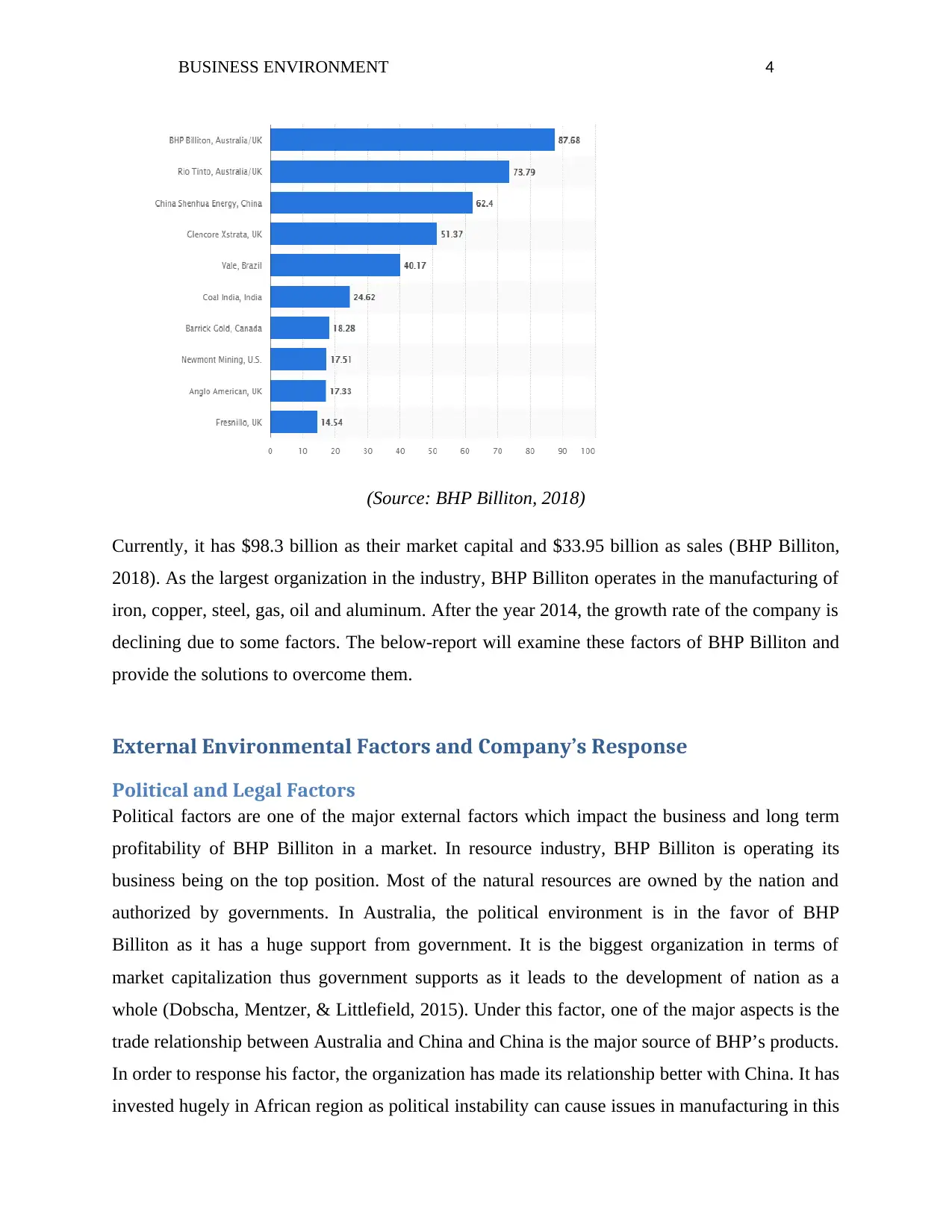
BUSINESS ENVIRONMENT 4
(Source: BHP Billiton, 2018)
Currently, it has $98.3 billion as their market capital and $33.95 billion as sales (BHP Billiton,
2018). As the largest organization in the industry, BHP Billiton operates in the manufacturing of
iron, copper, steel, gas, oil and aluminum. After the year 2014, the growth rate of the company is
declining due to some factors. The below-report will examine these factors of BHP Billiton and
provide the solutions to overcome them.
External Environmental Factors and Company’s Response
Political and Legal Factors
Political factors are one of the major external factors which impact the business and long term
profitability of BHP Billiton in a market. In resource industry, BHP Billiton is operating its
business being on the top position. Most of the natural resources are owned by the nation and
authorized by governments. In Australia, the political environment is in the favor of BHP
Billiton as it has a huge support from government. It is the biggest organization in terms of
market capitalization thus government supports as it leads to the development of nation as a
whole (Dobscha, Mentzer, & Littlefield, 2015). Under this factor, one of the major aspects is the
trade relationship between Australia and China and China is the major source of BHP’s products.
In order to response his factor, the organization has made its relationship better with China. It has
invested hugely in African region as political instability can cause issues in manufacturing in this
(Source: BHP Billiton, 2018)
Currently, it has $98.3 billion as their market capital and $33.95 billion as sales (BHP Billiton,
2018). As the largest organization in the industry, BHP Billiton operates in the manufacturing of
iron, copper, steel, gas, oil and aluminum. After the year 2014, the growth rate of the company is
declining due to some factors. The below-report will examine these factors of BHP Billiton and
provide the solutions to overcome them.
External Environmental Factors and Company’s Response
Political and Legal Factors
Political factors are one of the major external factors which impact the business and long term
profitability of BHP Billiton in a market. In resource industry, BHP Billiton is operating its
business being on the top position. Most of the natural resources are owned by the nation and
authorized by governments. In Australia, the political environment is in the favor of BHP
Billiton as it has a huge support from government. It is the biggest organization in terms of
market capitalization thus government supports as it leads to the development of nation as a
whole (Dobscha, Mentzer, & Littlefield, 2015). Under this factor, one of the major aspects is the
trade relationship between Australia and China and China is the major source of BHP’s products.
In order to response his factor, the organization has made its relationship better with China. It has
invested hugely in African region as political instability can cause issues in manufacturing in this
Paraphrase This Document
Need a fresh take? Get an instant paraphrase of this document with our AI Paraphraser
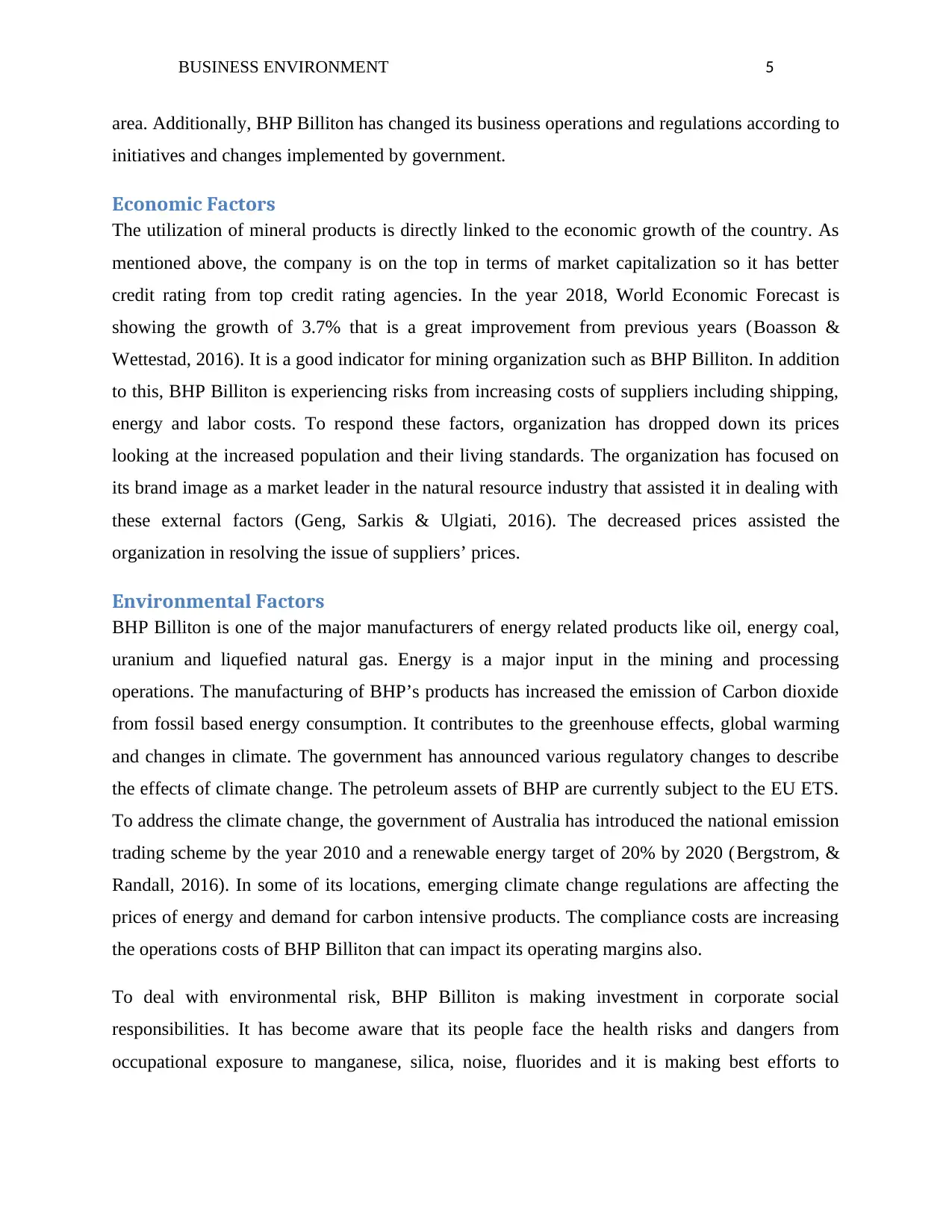
BUSINESS ENVIRONMENT 5
area. Additionally, BHP Billiton has changed its business operations and regulations according to
initiatives and changes implemented by government.
Economic Factors
The utilization of mineral products is directly linked to the economic growth of the country. As
mentioned above, the company is on the top in terms of market capitalization so it has better
credit rating from top credit rating agencies. In the year 2018, World Economic Forecast is
showing the growth of 3.7% that is a great improvement from previous years (Boasson &
Wettestad, 2016). It is a good indicator for mining organization such as BHP Billiton. In addition
to this, BHP Billiton is experiencing risks from increasing costs of suppliers including shipping,
energy and labor costs. To respond these factors, organization has dropped down its prices
looking at the increased population and their living standards. The organization has focused on
its brand image as a market leader in the natural resource industry that assisted it in dealing with
these external factors (Geng, Sarkis & Ulgiati, 2016). The decreased prices assisted the
organization in resolving the issue of suppliers’ prices.
Environmental Factors
BHP Billiton is one of the major manufacturers of energy related products like oil, energy coal,
uranium and liquefied natural gas. Energy is a major input in the mining and processing
operations. The manufacturing of BHP’s products has increased the emission of Carbon dioxide
from fossil based energy consumption. It contributes to the greenhouse effects, global warming
and changes in climate. The government has announced various regulatory changes to describe
the effects of climate change. The petroleum assets of BHP are currently subject to the EU ETS.
To address the climate change, the government of Australia has introduced the national emission
trading scheme by the year 2010 and a renewable energy target of 20% by 2020 (Bergstrom, &
Randall, 2016). In some of its locations, emerging climate change regulations are affecting the
prices of energy and demand for carbon intensive products. The compliance costs are increasing
the operations costs of BHP Billiton that can impact its operating margins also.
To deal with environmental risk, BHP Billiton is making investment in corporate social
responsibilities. It has become aware that its people face the health risks and dangers from
occupational exposure to manganese, silica, noise, fluorides and it is making best efforts to
area. Additionally, BHP Billiton has changed its business operations and regulations according to
initiatives and changes implemented by government.
Economic Factors
The utilization of mineral products is directly linked to the economic growth of the country. As
mentioned above, the company is on the top in terms of market capitalization so it has better
credit rating from top credit rating agencies. In the year 2018, World Economic Forecast is
showing the growth of 3.7% that is a great improvement from previous years (Boasson &
Wettestad, 2016). It is a good indicator for mining organization such as BHP Billiton. In addition
to this, BHP Billiton is experiencing risks from increasing costs of suppliers including shipping,
energy and labor costs. To respond these factors, organization has dropped down its prices
looking at the increased population and their living standards. The organization has focused on
its brand image as a market leader in the natural resource industry that assisted it in dealing with
these external factors (Geng, Sarkis & Ulgiati, 2016). The decreased prices assisted the
organization in resolving the issue of suppliers’ prices.
Environmental Factors
BHP Billiton is one of the major manufacturers of energy related products like oil, energy coal,
uranium and liquefied natural gas. Energy is a major input in the mining and processing
operations. The manufacturing of BHP’s products has increased the emission of Carbon dioxide
from fossil based energy consumption. It contributes to the greenhouse effects, global warming
and changes in climate. The government has announced various regulatory changes to describe
the effects of climate change. The petroleum assets of BHP are currently subject to the EU ETS.
To address the climate change, the government of Australia has introduced the national emission
trading scheme by the year 2010 and a renewable energy target of 20% by 2020 (Bergstrom, &
Randall, 2016). In some of its locations, emerging climate change regulations are affecting the
prices of energy and demand for carbon intensive products. The compliance costs are increasing
the operations costs of BHP Billiton that can impact its operating margins also.
To deal with environmental risk, BHP Billiton is making investment in corporate social
responsibilities. It has become aware that its people face the health risks and dangers from
occupational exposure to manganese, silica, noise, fluorides and it is making best efforts to
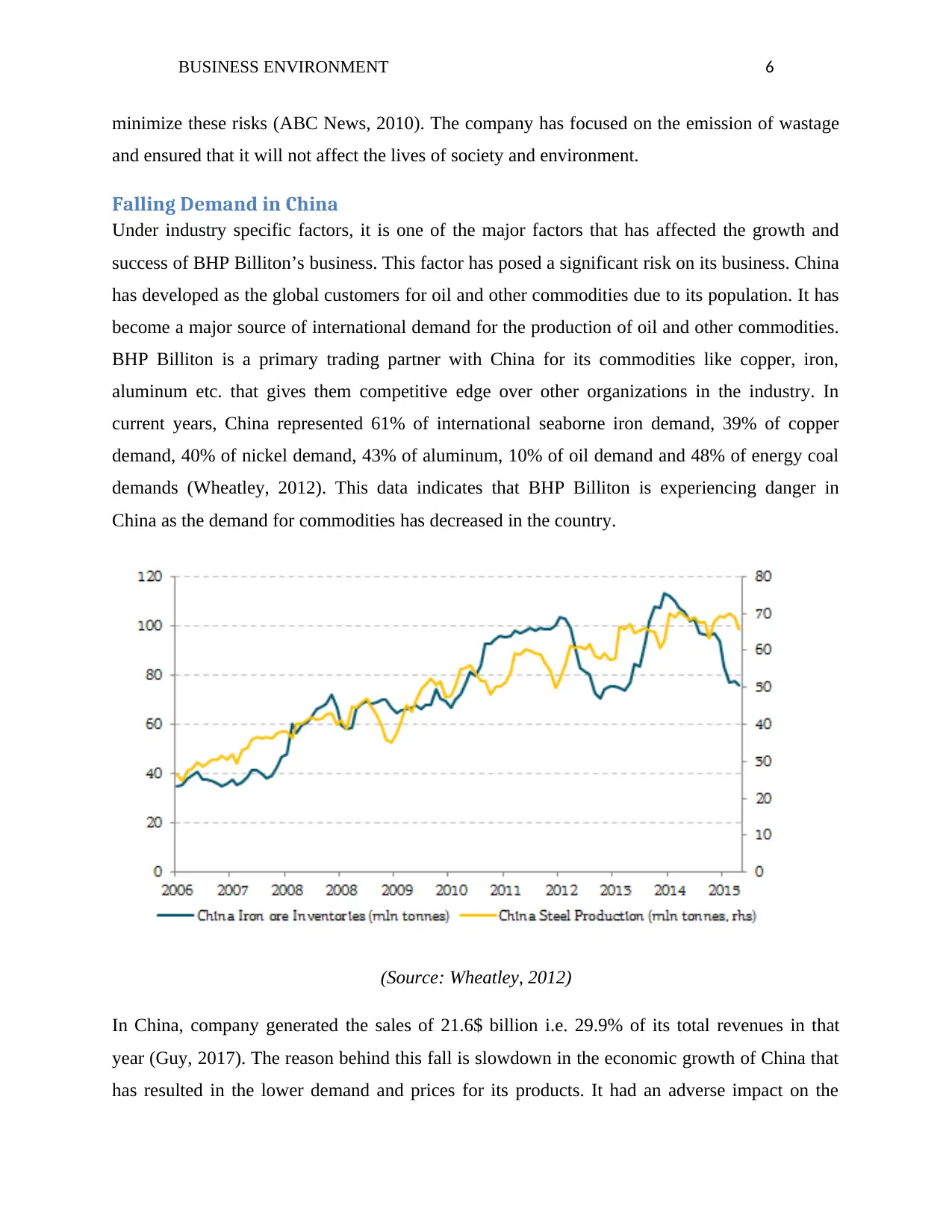
BUSINESS ENVIRONMENT 6
minimize these risks (ABC News, 2010). The company has focused on the emission of wastage
and ensured that it will not affect the lives of society and environment.
Falling Demand in China
Under industry specific factors, it is one of the major factors that has affected the growth and
success of BHP Billiton’s business. This factor has posed a significant risk on its business. China
has developed as the global customers for oil and other commodities due to its population. It has
become a major source of international demand for the production of oil and other commodities.
BHP Billiton is a primary trading partner with China for its commodities like copper, iron,
aluminum etc. that gives them competitive edge over other organizations in the industry. In
current years, China represented 61% of international seaborne iron demand, 39% of copper
demand, 40% of nickel demand, 43% of aluminum, 10% of oil demand and 48% of energy coal
demands (Wheatley, 2012). This data indicates that BHP Billiton is experiencing danger in
China as the demand for commodities has decreased in the country.
(Source: Wheatley, 2012)
In China, company generated the sales of 21.6$ billion i.e. 29.9% of its total revenues in that
year (Guy, 2017). The reason behind this fall is slowdown in the economic growth of China that
has resulted in the lower demand and prices for its products. It had an adverse impact on the
minimize these risks (ABC News, 2010). The company has focused on the emission of wastage
and ensured that it will not affect the lives of society and environment.
Falling Demand in China
Under industry specific factors, it is one of the major factors that has affected the growth and
success of BHP Billiton’s business. This factor has posed a significant risk on its business. China
has developed as the global customers for oil and other commodities due to its population. It has
become a major source of international demand for the production of oil and other commodities.
BHP Billiton is a primary trading partner with China for its commodities like copper, iron,
aluminum etc. that gives them competitive edge over other organizations in the industry. In
current years, China represented 61% of international seaborne iron demand, 39% of copper
demand, 40% of nickel demand, 43% of aluminum, 10% of oil demand and 48% of energy coal
demands (Wheatley, 2012). This data indicates that BHP Billiton is experiencing danger in
China as the demand for commodities has decreased in the country.
(Source: Wheatley, 2012)
In China, company generated the sales of 21.6$ billion i.e. 29.9% of its total revenues in that
year (Guy, 2017). The reason behind this fall is slowdown in the economic growth of China that
has resulted in the lower demand and prices for its products. It had an adverse impact on the
⊘ This is a preview!⊘
Do you want full access?
Subscribe today to unlock all pages.

Trusted by 1+ million students worldwide
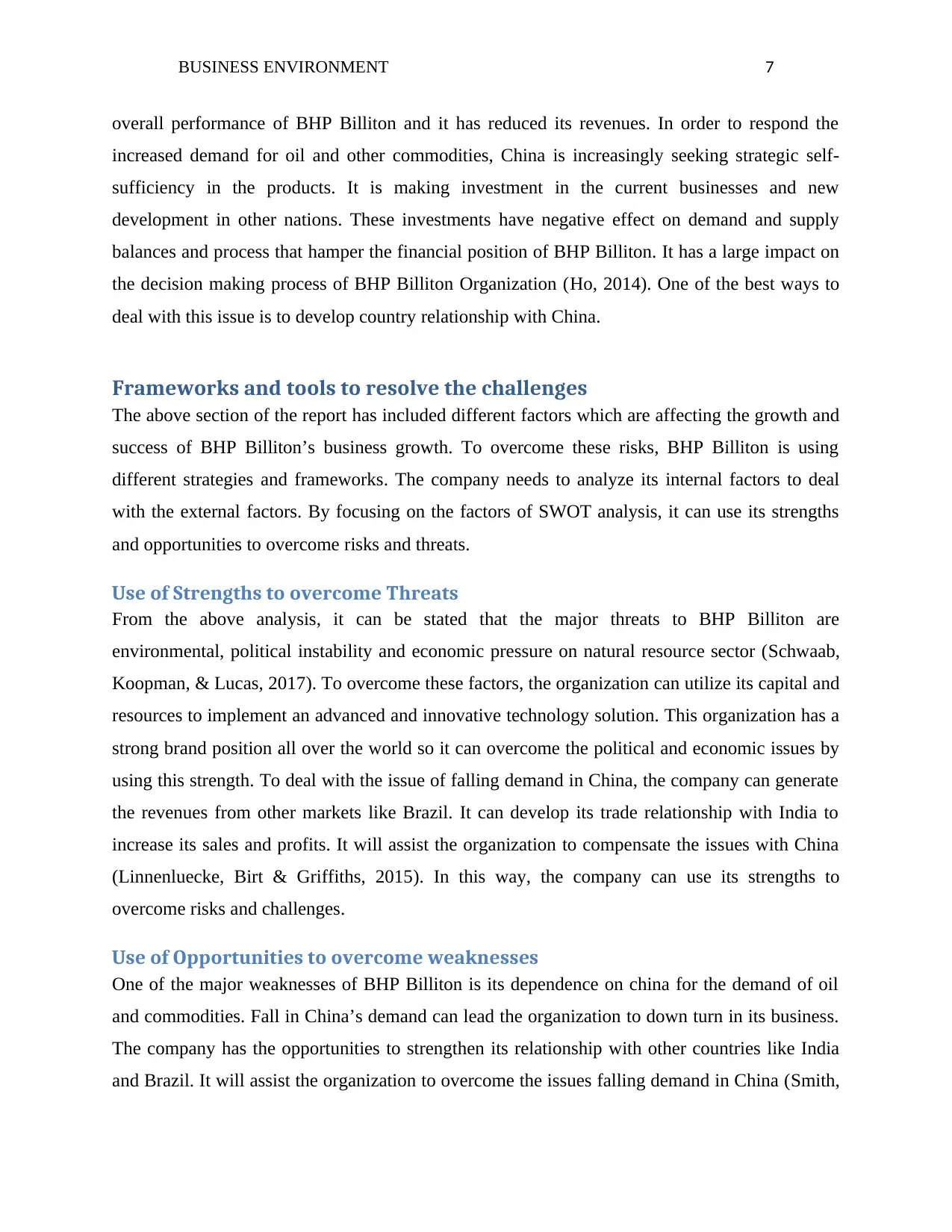
BUSINESS ENVIRONMENT 7
overall performance of BHP Billiton and it has reduced its revenues. In order to respond the
increased demand for oil and other commodities, China is increasingly seeking strategic self-
sufficiency in the products. It is making investment in the current businesses and new
development in other nations. These investments have negative effect on demand and supply
balances and process that hamper the financial position of BHP Billiton. It has a large impact on
the decision making process of BHP Billiton Organization (Ho, 2014). One of the best ways to
deal with this issue is to develop country relationship with China.
Frameworks and tools to resolve the challenges
The above section of the report has included different factors which are affecting the growth and
success of BHP Billiton’s business growth. To overcome these risks, BHP Billiton is using
different strategies and frameworks. The company needs to analyze its internal factors to deal
with the external factors. By focusing on the factors of SWOT analysis, it can use its strengths
and opportunities to overcome risks and threats.
Use of Strengths to overcome Threats
From the above analysis, it can be stated that the major threats to BHP Billiton are
environmental, political instability and economic pressure on natural resource sector (Schwaab,
Koopman, & Lucas, 2017). To overcome these factors, the organization can utilize its capital and
resources to implement an advanced and innovative technology solution. This organization has a
strong brand position all over the world so it can overcome the political and economic issues by
using this strength. To deal with the issue of falling demand in China, the company can generate
the revenues from other markets like Brazil. It can develop its trade relationship with India to
increase its sales and profits. It will assist the organization to compensate the issues with China
(Linnenluecke, Birt & Griffiths, 2015). In this way, the company can use its strengths to
overcome risks and challenges.
Use of Opportunities to overcome weaknesses
One of the major weaknesses of BHP Billiton is its dependence on china for the demand of oil
and commodities. Fall in China’s demand can lead the organization to down turn in its business.
The company has the opportunities to strengthen its relationship with other countries like India
and Brazil. It will assist the organization to overcome the issues falling demand in China (Smith,
overall performance of BHP Billiton and it has reduced its revenues. In order to respond the
increased demand for oil and other commodities, China is increasingly seeking strategic self-
sufficiency in the products. It is making investment in the current businesses and new
development in other nations. These investments have negative effect on demand and supply
balances and process that hamper the financial position of BHP Billiton. It has a large impact on
the decision making process of BHP Billiton Organization (Ho, 2014). One of the best ways to
deal with this issue is to develop country relationship with China.
Frameworks and tools to resolve the challenges
The above section of the report has included different factors which are affecting the growth and
success of BHP Billiton’s business growth. To overcome these risks, BHP Billiton is using
different strategies and frameworks. The company needs to analyze its internal factors to deal
with the external factors. By focusing on the factors of SWOT analysis, it can use its strengths
and opportunities to overcome risks and threats.
Use of Strengths to overcome Threats
From the above analysis, it can be stated that the major threats to BHP Billiton are
environmental, political instability and economic pressure on natural resource sector (Schwaab,
Koopman, & Lucas, 2017). To overcome these factors, the organization can utilize its capital and
resources to implement an advanced and innovative technology solution. This organization has a
strong brand position all over the world so it can overcome the political and economic issues by
using this strength. To deal with the issue of falling demand in China, the company can generate
the revenues from other markets like Brazil. It can develop its trade relationship with India to
increase its sales and profits. It will assist the organization to compensate the issues with China
(Linnenluecke, Birt & Griffiths, 2015). In this way, the company can use its strengths to
overcome risks and challenges.
Use of Opportunities to overcome weaknesses
One of the major weaknesses of BHP Billiton is its dependence on china for the demand of oil
and commodities. Fall in China’s demand can lead the organization to down turn in its business.
The company has the opportunities to strengthen its relationship with other countries like India
and Brazil. It will assist the organization to overcome the issues falling demand in China (Smith,
Paraphrase This Document
Need a fresh take? Get an instant paraphrase of this document with our AI Paraphraser
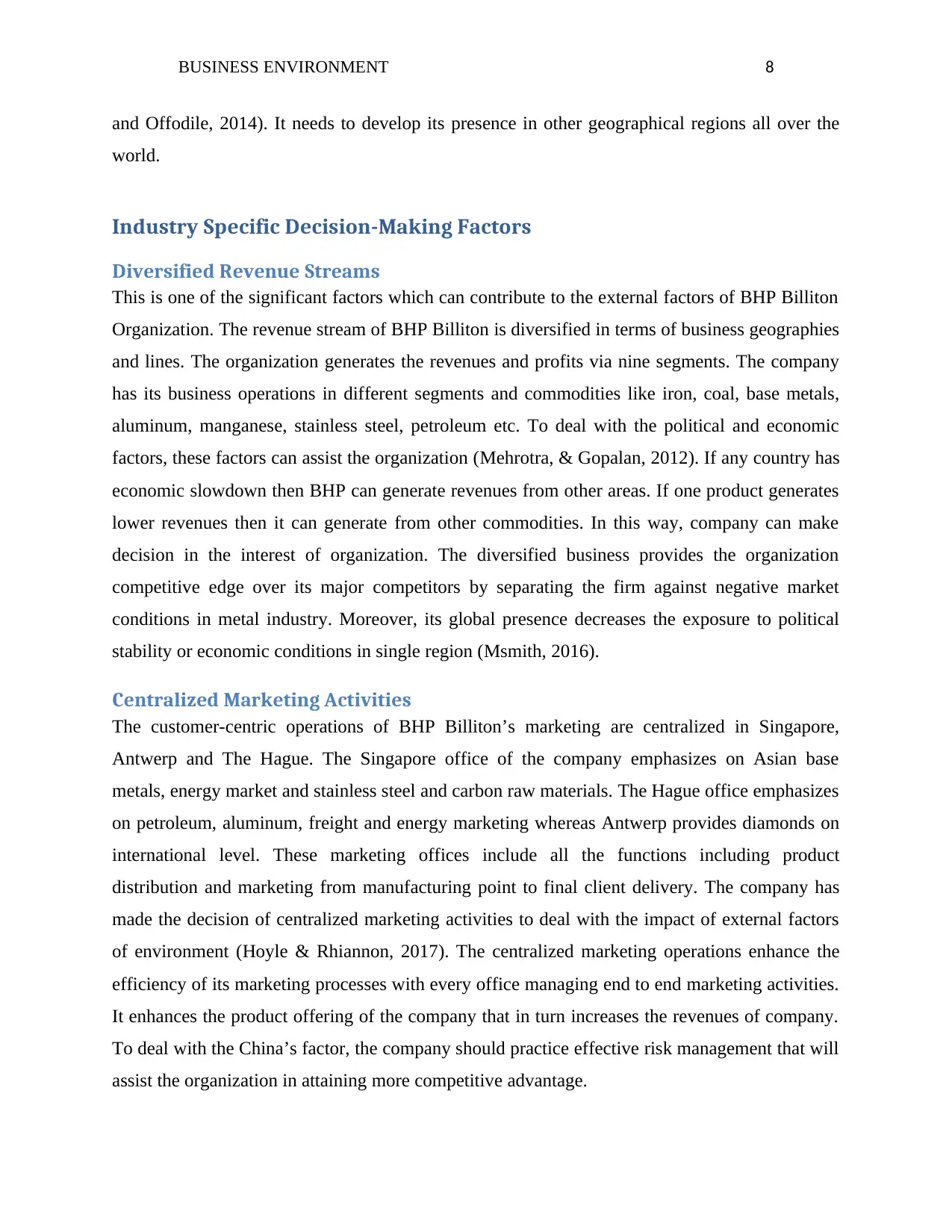
BUSINESS ENVIRONMENT 8
and Offodile, 2014). It needs to develop its presence in other geographical regions all over the
world.
Industry Specific Decision-Making Factors
Diversified Revenue Streams
This is one of the significant factors which can contribute to the external factors of BHP Billiton
Organization. The revenue stream of BHP Billiton is diversified in terms of business geographies
and lines. The organization generates the revenues and profits via nine segments. The company
has its business operations in different segments and commodities like iron, coal, base metals,
aluminum, manganese, stainless steel, petroleum etc. To deal with the political and economic
factors, these factors can assist the organization (Mehrotra, & Gopalan, 2012). If any country has
economic slowdown then BHP can generate revenues from other areas. If one product generates
lower revenues then it can generate from other commodities. In this way, company can make
decision in the interest of organization. The diversified business provides the organization
competitive edge over its major competitors by separating the firm against negative market
conditions in metal industry. Moreover, its global presence decreases the exposure to political
stability or economic conditions in single region (Msmith, 2016).
Centralized Marketing Activities
The customer-centric operations of BHP Billiton’s marketing are centralized in Singapore,
Antwerp and The Hague. The Singapore office of the company emphasizes on Asian base
metals, energy market and stainless steel and carbon raw materials. The Hague office emphasizes
on petroleum, aluminum, freight and energy marketing whereas Antwerp provides diamonds on
international level. These marketing offices include all the functions including product
distribution and marketing from manufacturing point to final client delivery. The company has
made the decision of centralized marketing activities to deal with the impact of external factors
of environment (Hoyle & Rhiannon, 2017). The centralized marketing operations enhance the
efficiency of its marketing processes with every office managing end to end marketing activities.
It enhances the product offering of the company that in turn increases the revenues of company.
To deal with the China’s factor, the company should practice effective risk management that will
assist the organization in attaining more competitive advantage.
and Offodile, 2014). It needs to develop its presence in other geographical regions all over the
world.
Industry Specific Decision-Making Factors
Diversified Revenue Streams
This is one of the significant factors which can contribute to the external factors of BHP Billiton
Organization. The revenue stream of BHP Billiton is diversified in terms of business geographies
and lines. The organization generates the revenues and profits via nine segments. The company
has its business operations in different segments and commodities like iron, coal, base metals,
aluminum, manganese, stainless steel, petroleum etc. To deal with the political and economic
factors, these factors can assist the organization (Mehrotra, & Gopalan, 2012). If any country has
economic slowdown then BHP can generate revenues from other areas. If one product generates
lower revenues then it can generate from other commodities. In this way, company can make
decision in the interest of organization. The diversified business provides the organization
competitive edge over its major competitors by separating the firm against negative market
conditions in metal industry. Moreover, its global presence decreases the exposure to political
stability or economic conditions in single region (Msmith, 2016).
Centralized Marketing Activities
The customer-centric operations of BHP Billiton’s marketing are centralized in Singapore,
Antwerp and The Hague. The Singapore office of the company emphasizes on Asian base
metals, energy market and stainless steel and carbon raw materials. The Hague office emphasizes
on petroleum, aluminum, freight and energy marketing whereas Antwerp provides diamonds on
international level. These marketing offices include all the functions including product
distribution and marketing from manufacturing point to final client delivery. The company has
made the decision of centralized marketing activities to deal with the impact of external factors
of environment (Hoyle & Rhiannon, 2017). The centralized marketing operations enhance the
efficiency of its marketing processes with every office managing end to end marketing activities.
It enhances the product offering of the company that in turn increases the revenues of company.
To deal with the China’s factor, the company should practice effective risk management that will
assist the organization in attaining more competitive advantage.
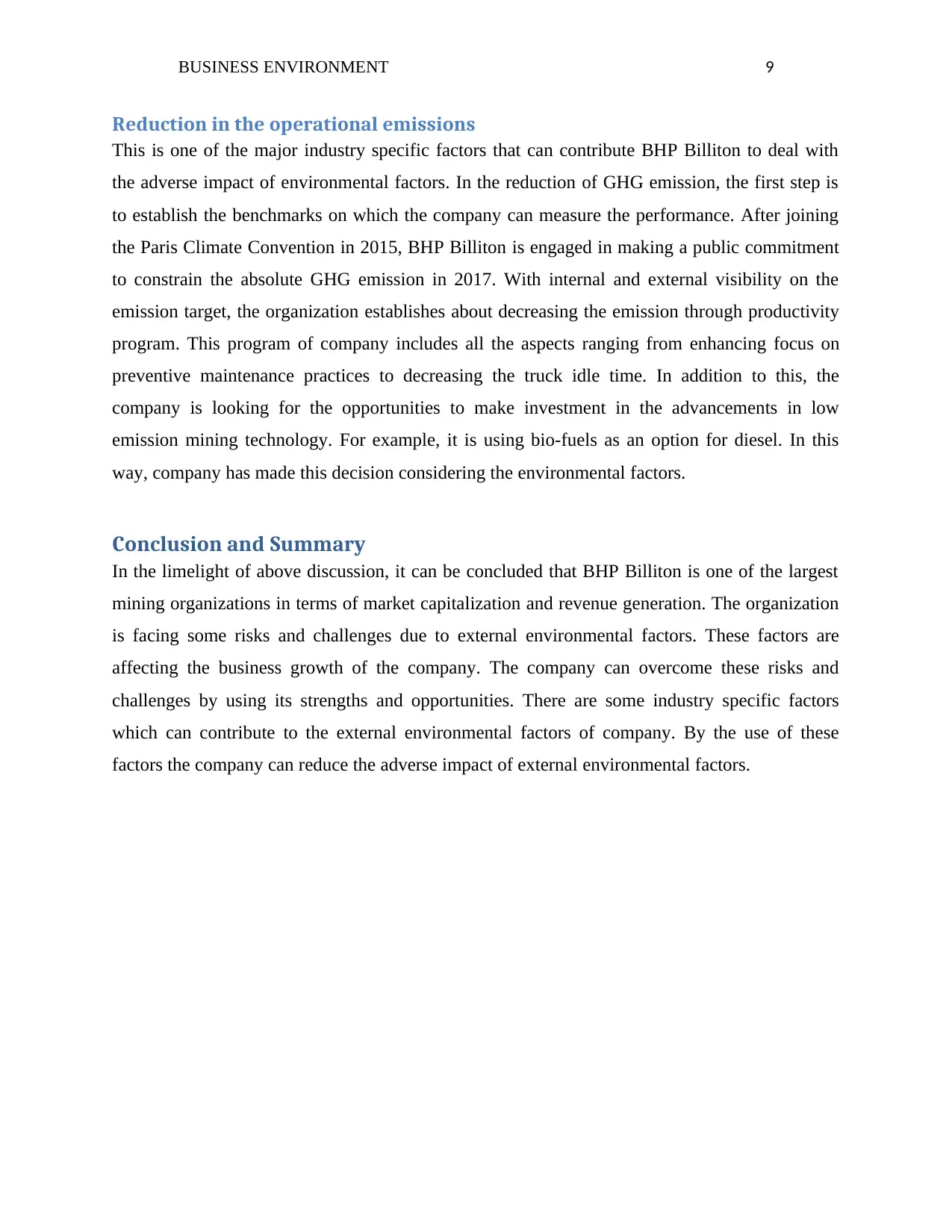
BUSINESS ENVIRONMENT 9
Reduction in the operational emissions
This is one of the major industry specific factors that can contribute BHP Billiton to deal with
the adverse impact of environmental factors. In the reduction of GHG emission, the first step is
to establish the benchmarks on which the company can measure the performance. After joining
the Paris Climate Convention in 2015, BHP Billiton is engaged in making a public commitment
to constrain the absolute GHG emission in 2017. With internal and external visibility on the
emission target, the organization establishes about decreasing the emission through productivity
program. This program of company includes all the aspects ranging from enhancing focus on
preventive maintenance practices to decreasing the truck idle time. In addition to this, the
company is looking for the opportunities to make investment in the advancements in low
emission mining technology. For example, it is using bio-fuels as an option for diesel. In this
way, company has made this decision considering the environmental factors.
Conclusion and Summary
In the limelight of above discussion, it can be concluded that BHP Billiton is one of the largest
mining organizations in terms of market capitalization and revenue generation. The organization
is facing some risks and challenges due to external environmental factors. These factors are
affecting the business growth of the company. The company can overcome these risks and
challenges by using its strengths and opportunities. There are some industry specific factors
which can contribute to the external environmental factors of company. By the use of these
factors the company can reduce the adverse impact of external environmental factors.
Reduction in the operational emissions
This is one of the major industry specific factors that can contribute BHP Billiton to deal with
the adverse impact of environmental factors. In the reduction of GHG emission, the first step is
to establish the benchmarks on which the company can measure the performance. After joining
the Paris Climate Convention in 2015, BHP Billiton is engaged in making a public commitment
to constrain the absolute GHG emission in 2017. With internal and external visibility on the
emission target, the organization establishes about decreasing the emission through productivity
program. This program of company includes all the aspects ranging from enhancing focus on
preventive maintenance practices to decreasing the truck idle time. In addition to this, the
company is looking for the opportunities to make investment in the advancements in low
emission mining technology. For example, it is using bio-fuels as an option for diesel. In this
way, company has made this decision considering the environmental factors.
Conclusion and Summary
In the limelight of above discussion, it can be concluded that BHP Billiton is one of the largest
mining organizations in terms of market capitalization and revenue generation. The organization
is facing some risks and challenges due to external environmental factors. These factors are
affecting the business growth of the company. The company can overcome these risks and
challenges by using its strengths and opportunities. There are some industry specific factors
which can contribute to the external environmental factors of company. By the use of these
factors the company can reduce the adverse impact of external environmental factors.
⊘ This is a preview!⊘
Do you want full access?
Subscribe today to unlock all pages.

Trusted by 1+ million students worldwide

BUSINESS ENVIRONMENT 10
Paraphrase This Document
Need a fresh take? Get an instant paraphrase of this document with our AI Paraphraser
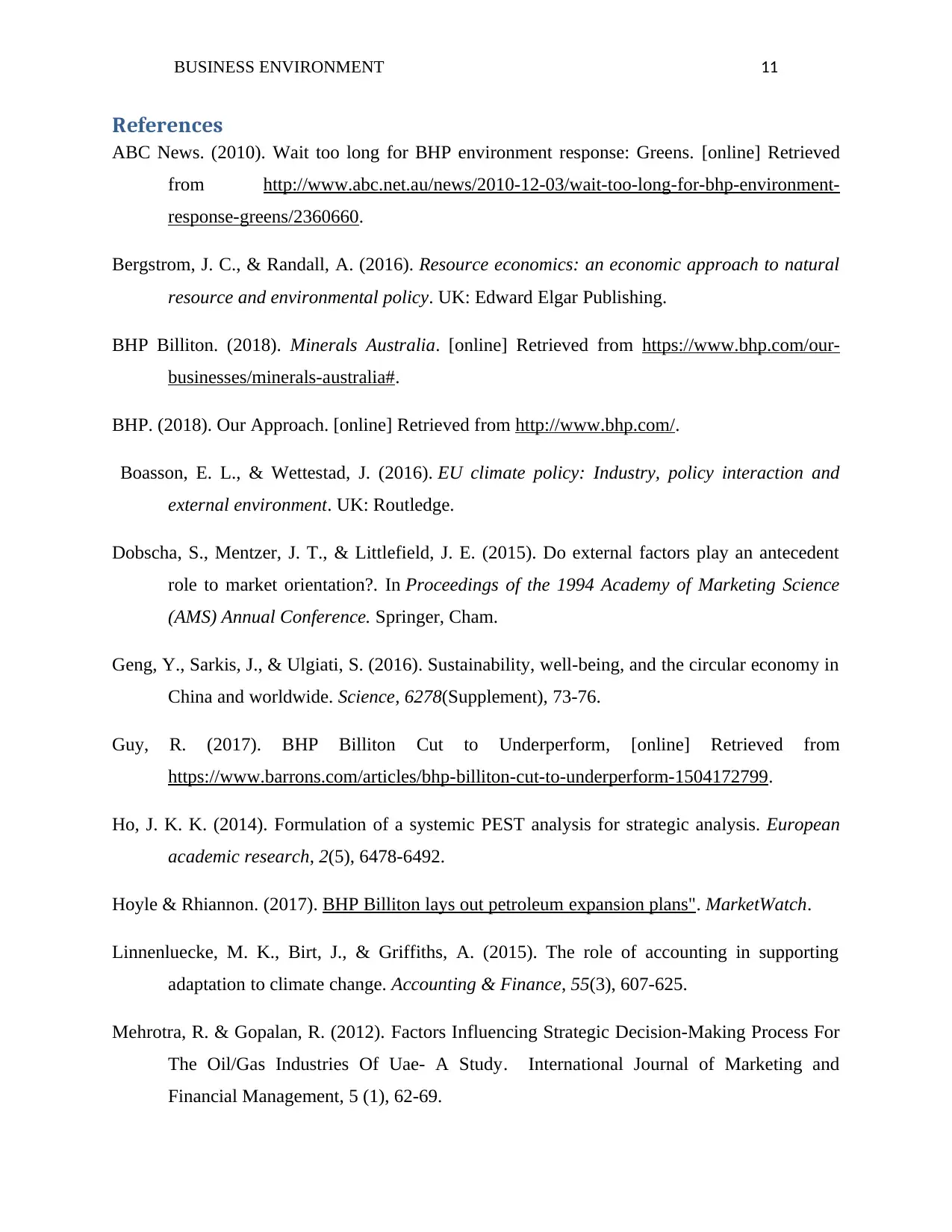
BUSINESS ENVIRONMENT 11
References
ABC News. (2010). Wait too long for BHP environment response: Greens. [online] Retrieved
from http://www.abc.net.au/news/2010-12-03/wait-too-long-for-bhp-environment-
response-greens/2360660.
Bergstrom, J. C., & Randall, A. (2016). Resource economics: an economic approach to natural
resource and environmental policy. UK: Edward Elgar Publishing.
BHP Billiton. (2018). Minerals Australia. [online] Retrieved from https://www.bhp.com/our-
businesses/minerals-australia#.
BHP. (2018). Our Approach. [online] Retrieved from http://www.bhp.com/.
Boasson, E. L., & Wettestad, J. (2016). EU climate policy: Industry, policy interaction and
external environment. UK: Routledge.
Dobscha, S., Mentzer, J. T., & Littlefield, J. E. (2015). Do external factors play an antecedent
role to market orientation?. In Proceedings of the 1994 Academy of Marketing Science
(AMS) Annual Conference. Springer, Cham.
Geng, Y., Sarkis, J., & Ulgiati, S. (2016). Sustainability, well-being, and the circular economy in
China and worldwide. Science, 6278(Supplement), 73-76.
Guy, R. (2017). BHP Billiton Cut to Underperform, [online] Retrieved from
https://www.barrons.com/articles/bhp-billiton-cut-to-underperform-1504172799.
Ho, J. K. K. (2014). Formulation of a systemic PEST analysis for strategic analysis. European
academic research, 2(5), 6478-6492.
Hoyle & Rhiannon. (2017). BHP Billiton lays out petroleum expansion plans". MarketWatch.
Linnenluecke, M. K., Birt, J., & Griffiths, A. (2015). The role of accounting in supporting
adaptation to climate change. Accounting & Finance, 55(3), 607-625.
Mehrotra, R. & Gopalan, R. (2012). Factors Influencing Strategic Decision-Making Process For
The Oil/Gas Industries Of Uae- A Study. International Journal of Marketing and
Financial Management, 5 (1), 62-69.
References
ABC News. (2010). Wait too long for BHP environment response: Greens. [online] Retrieved
from http://www.abc.net.au/news/2010-12-03/wait-too-long-for-bhp-environment-
response-greens/2360660.
Bergstrom, J. C., & Randall, A. (2016). Resource economics: an economic approach to natural
resource and environmental policy. UK: Edward Elgar Publishing.
BHP Billiton. (2018). Minerals Australia. [online] Retrieved from https://www.bhp.com/our-
businesses/minerals-australia#.
BHP. (2018). Our Approach. [online] Retrieved from http://www.bhp.com/.
Boasson, E. L., & Wettestad, J. (2016). EU climate policy: Industry, policy interaction and
external environment. UK: Routledge.
Dobscha, S., Mentzer, J. T., & Littlefield, J. E. (2015). Do external factors play an antecedent
role to market orientation?. In Proceedings of the 1994 Academy of Marketing Science
(AMS) Annual Conference. Springer, Cham.
Geng, Y., Sarkis, J., & Ulgiati, S. (2016). Sustainability, well-being, and the circular economy in
China and worldwide. Science, 6278(Supplement), 73-76.
Guy, R. (2017). BHP Billiton Cut to Underperform, [online] Retrieved from
https://www.barrons.com/articles/bhp-billiton-cut-to-underperform-1504172799.
Ho, J. K. K. (2014). Formulation of a systemic PEST analysis for strategic analysis. European
academic research, 2(5), 6478-6492.
Hoyle & Rhiannon. (2017). BHP Billiton lays out petroleum expansion plans". MarketWatch.
Linnenluecke, M. K., Birt, J., & Griffiths, A. (2015). The role of accounting in supporting
adaptation to climate change. Accounting & Finance, 55(3), 607-625.
Mehrotra, R. & Gopalan, R. (2012). Factors Influencing Strategic Decision-Making Process For
The Oil/Gas Industries Of Uae- A Study. International Journal of Marketing and
Financial Management, 5 (1), 62-69.
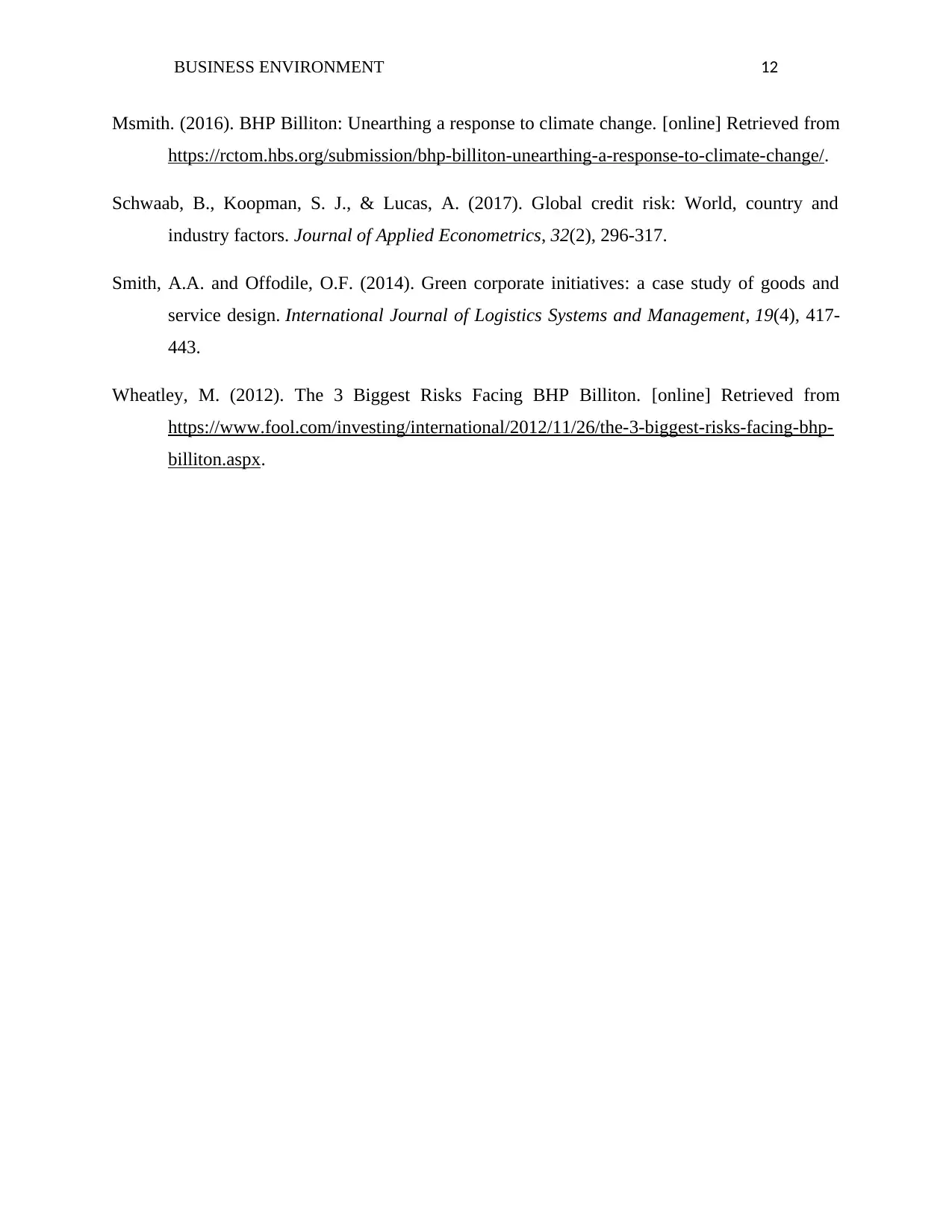
BUSINESS ENVIRONMENT 12
Msmith. (2016). BHP Billiton: Unearthing a response to climate change. [online] Retrieved from
https://rctom.hbs.org/submission/bhp-billiton-unearthing-a-response-to-climate-change/.
Schwaab, B., Koopman, S. J., & Lucas, A. (2017). Global credit risk: World, country and
industry factors. Journal of Applied Econometrics, 32(2), 296-317.
Smith, A.A. and Offodile, O.F. (2014). Green corporate initiatives: a case study of goods and
service design. International Journal of Logistics Systems and Management, 19(4), 417-
443.
Wheatley, M. (2012). The 3 Biggest Risks Facing BHP Billiton. [online] Retrieved from
https://www.fool.com/investing/international/2012/11/26/the-3-biggest-risks-facing-bhp-
billiton.aspx.
Msmith. (2016). BHP Billiton: Unearthing a response to climate change. [online] Retrieved from
https://rctom.hbs.org/submission/bhp-billiton-unearthing-a-response-to-climate-change/.
Schwaab, B., Koopman, S. J., & Lucas, A. (2017). Global credit risk: World, country and
industry factors. Journal of Applied Econometrics, 32(2), 296-317.
Smith, A.A. and Offodile, O.F. (2014). Green corporate initiatives: a case study of goods and
service design. International Journal of Logistics Systems and Management, 19(4), 417-
443.
Wheatley, M. (2012). The 3 Biggest Risks Facing BHP Billiton. [online] Retrieved from
https://www.fool.com/investing/international/2012/11/26/the-3-biggest-risks-facing-bhp-
billiton.aspx.
⊘ This is a preview!⊘
Do you want full access?
Subscribe today to unlock all pages.

Trusted by 1+ million students worldwide
1 out of 13
Related Documents
Your All-in-One AI-Powered Toolkit for Academic Success.
+13062052269
info@desklib.com
Available 24*7 on WhatsApp / Email
![[object Object]](/_next/static/media/star-bottom.7253800d.svg)
Unlock your academic potential
Copyright © 2020–2025 A2Z Services. All Rights Reserved. Developed and managed by ZUCOL.




